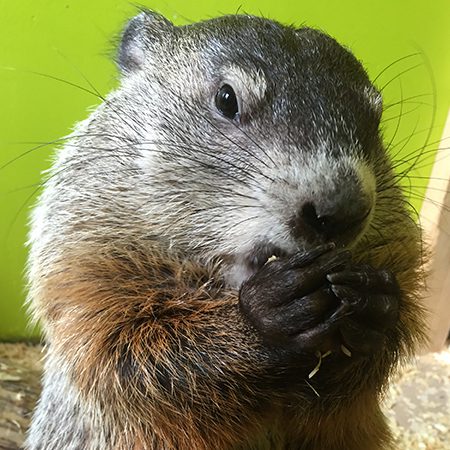Groundhog
Marmota monax
Groundhogs, also known as a woodchuck, chuck, whistlepig, or thickwood badger, is a rodent of the family Sciuridae, a group of large ground squirrels known as marmots. Groundhogs are well adapted for digging, with short, powerful limbs and curved, thick claws. Despite their heavy bodied appearance, groundhogs are accomplished swimmers and occasionally climb trees.
These animals are found through much of the eastern United States across Canada and into Alaska. Adults are 16 - 20 inches long, including a six inch tail. Average groundhog weight ranges from 5 to 12 pounds. Groundhogs have 4 iconic incisor teeth, these teeth are constantly growing about 1.5 mm per week. Constant usage wears them down about the same amount each week. They have a mostly herbivorous diet, eating wild grasses, berries, agricultural crops, and other vegetation found in the wild.
Groundhogs prefer open country fields and the edges of woodland, making sure to always stay in close range to a burrow entrance. They are typically found in low-elevation forests, small woodlots, fields, pastures, and hedgerows. In the wild, groundhogs live up to six years. To contrast, in captivity, they can live up to 14 years. Natural predators of the groundhog are humans, dogs, coyotes, foxes, and large birds of prey. When a groundhog senses danger in the wild, they will become motionless and hyper-alert whistling when alarmed to war other groundhogs. They will retreat to their burrows when threatened, and defend themselves with their large teeth and front claws.

Groundhogs are typically found in the low-elevation forests, small woodlots, fields, pastures and hedgerows of North America.
HABITAT -Typically found in low-elevation forests, small woodlots, fields, pastures, and hedgerows across North America.
DIET -Herbivorous diet, eating wild grasses, berries, agricultural crops, and other vegetation found in the wild.
FUN FACT -Groundhogs are true hibernators, sleeping for most of three months during colder weather.
SOCIAL BEHAVIOR -They create burrows to live in and also raise their young.
ACTIVITY -They are mainly active during the daytime, making them diurnal.
PREDATORS -Predators include humans, dogs, coyotes, and foxes.
SIZE -Adults are 16 - 20 in long, including a six inch tail. Average groundhog weight ranges from 5 to 12 lbs.
RELATIVES -There are 14 species of marmots, all related, examples include the yellow-bellied and hoary marmot.
CONSERVATION -Groundhogs are considered Least Concern on the IUCN Red List.
Cub Creek Animal Care Information
Housing - We have our groundhog living in a specialized enclosure, which is a large open room, giving him plenty of space to explore! His indoor enclosure is bedded with lots of hay, that he loves rearranging. There are also large branches and wooden log hides for him to sleep in. There is a space that allows for him to always have access to clean water.
Diet - Our groundhog gets a variety of foods, helping to ensure he gets all the daily nutrition he needs! His diet consists of sweet potato, banana, rodent blocks, and rabbit pellets. He loves gnawing on large chunks of sweet potato. He sometimes gets special dried fruit treats.
Enrichment - Our groundhog gets a lot of special attention from our director, he loves to snuggle up and will give kisses to them. They’ve formed a special bond with our director, and can sometimes be wary of meeting new people. Our groundhog is given large blocks of wood and tree branches to rearrange his home, as well as toys made from cardboard. They also gets special dried fruit treats, sometimes we’ll let him roam about freely in the building of their enclosure.

